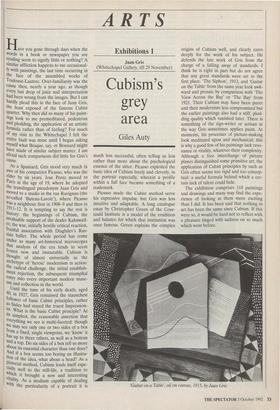ARTS
Exhibitions 1
Juan Gris
(Whitechapel Gallery, till 29 November)
Cubism's grey area
Giles Auty
Have you gone through days when the words in a book or newspaper you are reading seem to signify little or nothing? A similar affliction happens to me occasional- ly with paintings, the last time occurring in the face of the assembled works of Toulouse-Lautrec. Over-familiarity was the cause then, nearly a year ago, as though every last drop of juice and interpretation had been wrung from the images. But I can hardly plead this in the face of Juan Gris, the least exposed of the famous Cubist
• quartet. Why then did so many of his paint- ings look to me premeditated, pedestrian and plodding, the application of an artistic formula rather than of feeling? For much of my visit to the Whitechapel I felt the entire fault was mine until I began asking myself what Braque, say, or Bonnard might have made of similar subject matter. I am afraid such comparisons did little for Gris's cause.
As a Spaniard, Gris stood very much in awe of his compatriot Picasso, who was the elder by six years. Jose Perez moved to Paris at the age of 19, where he adopted the translingual pseudonym Juan Gris and moved to a studio in the rue Ravignan (the so-called `Bateau-Lavoir'), where Picasso was a neighbour first in 1908-9 and then in 1911-12. It is tempting to say the rest is history: the beginnings of Cubism, the invaluable support of the dealer Kahnweil- er, the war, initially hostile critical reaction, fruitful association with Diaghilev's Rus- sian ballet. The whole period has come under so many art-historical microscopes that analysis of the era tends to seem frozen now and immutable. Cubism is thought of almost universally as the archetype of 'heroic' modernism in action: the radical challenge, the initial establish- ment rejection, the subsequent triumphal entry into every important modern muse- um and collection in the world. Until the time of his early death, aged 413, in 1927, Gris remained the staunchest follower of basic Cubist principles, rather as Sisley had stayed the truest Impression- ist. What is the basic Cubist principle? At Its simplest, the reasonable assertion that everything we see is multi-faceted: though We may see only one or two sides of a box from a fixed, single viewpoint, we 'know' it has up to three others, as well as a bottom and a top. Do six sides of a box tell us more about its essential character than one does? And if a box seems too boring an illustra- tion of the idea, what about a head? As a pictorial method, Cubism lends itself espe- cially well to the still-life, a tradition to Which it brought a new and interesting vitality. As a medium capable of dealing with the particularity of a portrait it is
much less successful, often telling us less rather than more about the psychological essence of the sitter. Picasso exploited the basic idea of Cubism freely and cleverly, in the portrait especially, wherein a profile within a full face became something of a trademark.
Picasso made the Cubist method serve his expressive impulse, but Gris was less intuitive and adaptable. A long catalogue essay by Christopher Green of the Cour- tauld Institute is a model of the erudition and balance for which that institution was once famous. Green explains the complex origins of Cubism well, and clearly cares deeply for the work of his subject. He defends the late work of Gris from the charge of a falling away of standards. I think he is right in part but do not agree that any great standards were set in the first place. The Siphon', 1913, and 'Guitar on the Table' from the same year look awk- ward and prosaic by comparison with 'The View Across the Bay' or 'The Bay' from 1921. Their Cubism may have been purer and their modernism less compromised but the earlier paintings also had a stiff, plod- ding quality which vanished later. There is something of the sign-writer or artisan in the way Gris sometimes applies paint. At moments, his processes of picture-making look meditated upon and mechanical; this is why a good few of his paintings lack reso- nance or vitality, whatever their complexity. Although a free interchange of picture planes distinguished some primitive art, the application of Cubist principles by such as Gris often seems too rigid and too concep- tual: a useful formula behind which a cer- tain lack of talent could hide.
The exhibition comprises 118 paintings and drawings and many may find the expe- rience of looking at them more exciting than I did. It has been said that nothing in art has been the same since Cubism. If this were so, it would be hard not to reflect with a pleasure tinged with sadness on so much which went before.
'Guitar on a Table, oil on canvas, 1915, by Juan Cris


















































 Previous page
Previous page